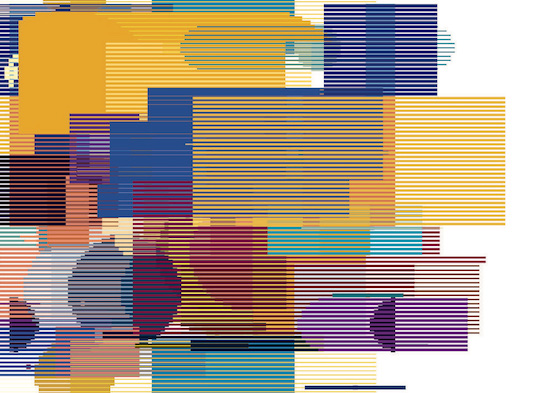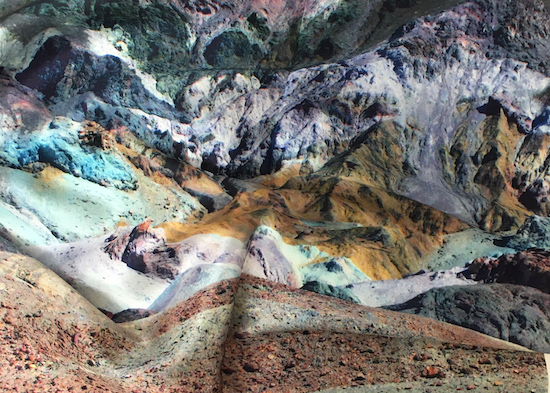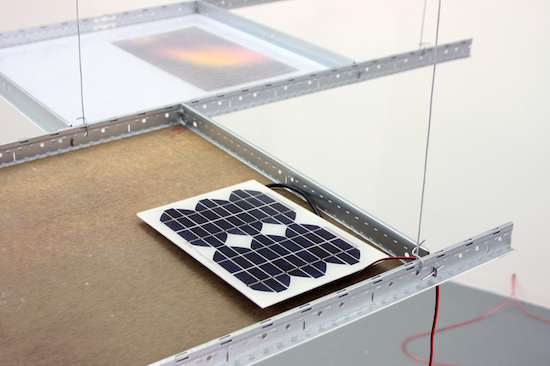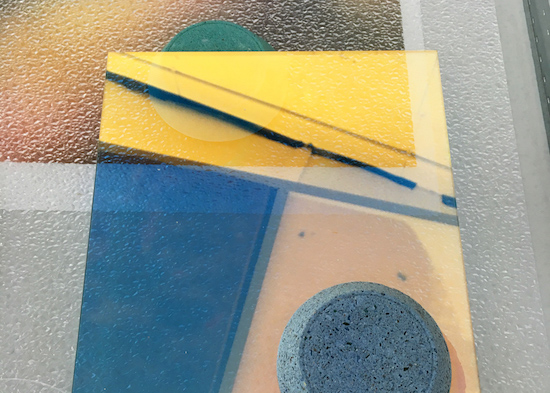Detail of: I am ten thousand cathedrals rolled into one, 2016, (Galvanised steel, acrylic, glass, digital print, concrete)
There is a novel by Clive Barker about a world within a rug. I remember reading Weaveworld as a child, though I recall few of the details now. It concerns a magical race called the Seerkind who have used their powers to build themselves a place of refuge, a kind of protected kingdom hidden in the weave of what appears to be just an ordinary carpet. It’s been years since I read that book, but it springs to mind somehow as I sit in the East London studio of artist Lilah Fowler as she shows me a silk scarf she’s had made with an image of Death Valley printed on it.
“These are just small prototypes for a series of scarves that I’m making,” she explains. “They’re images from these national parks that I visited. I’ve been thinking about the way we see landscapes, these designated protected areas, but they’re not really natural at all. Landscape is a false way of looking at the world. It’s something that came after the industrial revolution, when everyone left to work in the cities and started to idealised what was left behind.”
Fowler refers to the scarf in her hands as a “wearable”, a sort of “merchandise”. “Everyone goes to these national parks,” she says, “and they take photos, they want something from the gift shop, postcards, whatever. So it was just this idea of making something that was a really heightened, unnatural version of that as a commodity.”
The particular image printed on the scarf in front of me is from an area in Death Valley known as the ‘painter’s palette’ for the bright colours of the rock caused by the oxidisation of different compounds embedded in the landscape. Fowler has exaggerated these colours even further to bring out the garishness of the image, emphasise the commodity status of the territory itself.
With the rise of Lonely Planet-style tourism, in particular, the idea of the designated area of natural beauty has become especially fetishised. We dream about ‘getting away from it all’, re-communing with nature. But nothing is more cultural, nothing is more indelibly a product of the contemporary hyper-capitalism that this desire. “Technology is inherently something that’s apart of that,” Fowler says, using colour ‘correction’ software, amping up the artificiality of the scene, and self-consciously marketing the image of the landscape as a product, is just a way of emphasising that, drawing it to one’s attention.
She speaks of “Nth nature.” Of course, everything has been touched, formed, affected by human culture. But beyond that, there remains an “almost infinite layer of natures,” extending kaleidoscopically, to the nth degree, to infinity.

Untitled, 2016, (Computer generated digital image)
Landscape – as haven, as physical space, and as cultural construct – figures heavily in Fowler’s work. A great deal of her work is site-specific, whether that’s for a concrete platform in the Joshua Tree desert or a dance studio in South London. But sometimes the landscapes in her work are at least as virtual as they are real – or at least, they seem to in habit some uncertain place in-between.
For an online exhibition mounted by Maria Stenfors Gallery in July of 2015, Fowler mapped the traceroute of visitors to the gallery website. Beneath an animation of geological survey maps melting and shifting unsteadily into each other, a small box asks for your GPS coordinates, “but what happens is,” Fowler explains, “when people click into that, I will automatically get an email with their location – and I still get them now. Every once in a while there’s something. I get a Google maps location and it shows me wherever that person is in the world. It’s almost like a database I’ve basically been amassing since that point.”
The weird maps of use, enquiry, curiosity, and happenstance that are emerging from that process will undoubtedly find their way into some future work. “I always thought it would be nice to make something more physical from this data. I was thinking about how I could translate that into patterns. If I’m thinking about rugs…”
When we meet, Fowler is getting ready to leave. A week later she’s off on another residency, in America this time, deep into the desert without wifi, or phone reception – scarcely even a postman. While she’s there, she’s looking forward to learning about rug-weaving, on a course run by Native Americans in Denver, Colorado. Her interest in this course reflects a felt need to learn the physical process of things, to feel her materials, and understand the techniques that underly everyday objects. It’s not necessarily a question of a recourse to homespun craft activity – as Fowler reminds me, the textile industry was the beginning, with the punched cards of the Jacquard loom, of the information revolution. Spun silk was a sort of digital art centuries before the fact.

36.221, -116.725, 1648 m, 2016, (Silk Scarf)
Her space in this Homerton warehouse is dominated by a large galvanised steel frame suspended from the ceiling. In fact, I’ve seen it before. In January, earlier this year, the same frame was strung up in the Hackney gallery, The Space In Between, for a collaborative show with James Irwin. Milling about at the private view I was aware of an eerie hum pervading the space. “The gallery’s wifi feed was linked up to the software that we had,” Fowler explains to me. “So whenever there was heightened activity – it could be that they’ve gone on a web browser, watching a YouTube video, sending an email, anything – that would be relayed into sound.”
“The original sound is from a recording I took next to a wind turbine,” she continues. “So the kind of drone of that was then relayed into music software and we basically chose different tones from that recording to create a range of tones that this could then pick up and that was used to create the sound. So if it became busier, that would be a different tone. And if it was totally inactive, then it would just become silent.” The frame is back up in the studio now because Irwin and Fowler are planning their next move together, some kind of sequel to the show, building, particularly, on this live element of the previous show.

I am ten thousand cathedrals rolled into one, 2016, (Galvanised steel, laminate, acrylic, digital print, solar panel, fan)
But before that, Fowler has two major public art projects on the go. One, just about to open in Bristol, involves cladding sections of a fire escape in New Bridewell, Bristol, in algorithmically-generated images. The other, perhaps even more ambitiously, will relay a pattern of coloured lights, alternately blue and yellow in a binary pattern, twenty-four-seven, on a building currently being erected on Tottenham Court Road, London. This latter piece relates to a renewed interest in cryptography for Fowler, Encoded in the arrangement of the lights will be a secret message about knowledge – and its limitations.
“It’s partly about this back and forth between analogue and digital,” Fowler explains. “I always find it interesting going into something and trying to figure out what you can use from it to make something else.”
Lilah Fowler’s commission for New Bridewell in Bristol is due for completion in October. Her project for One Bedford Avenue, Bloomsbury, is expected to be finished by February next year. For more details, visit her website


